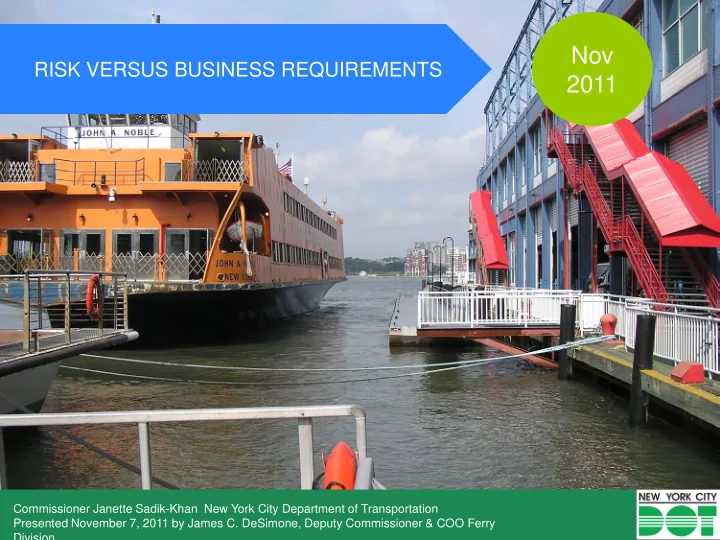

Nov RISK VERSUS BUSINESS REQUIREMENTS 2011 Commissioner Janette Sadik-Khan New York City Department of Transportation Presented November 7, 2011 by James C. DeSimone, Deputy Commissioner & COO Ferry Division
RISK According to the Business Dictionary : risk is the probability or threat of damage, injury, liability, loss or other negative occurrence that is caused by external or internal vulnerabilities and may be neutralized through preemptive action the probability that actual return will be less than expected return
Business Requirements According to Merriam-Webster Dictionary : requirement is defined as something essential to the existence or occurrence of something else business requirement is defined as something essential to the existence of the business - in the private sector, organizational existence is primarily dependent on profitability, while in the public sector tends to be dependent on the service provided versus a public need
External Vulnerabilities ENVIRONMENTAL a vessel goes to sea and is battered by heavy weather that results in loss of containers overboard, or a hull fracture and pollution, or passengers thrown around and injured as a vessel is docking an unanticipated heavy current causes it to allide with a pier resulting in hull damage a vessel collides with another vessel through no fault of its own resulting in loss of life and damage to the vessel Security or Threat-based an oil tanker is rammed by a terrorist small craft resulting in loss of life and pollution a ferry is boarded by a passenger with an IED in backpack that is detonated in passenger spaces resulting in loss of life and damage a port experiences a terrorist attack that results in a complete business shut down
Internal Vulnerabilities physical fitness - the captain of an oil tanker becomes incapacitated while approaching pilot station which results in the vessel grounding and pollution human error - a crew member on a passenger vessel ignores the vessel security plan which results in a major security breach, injury to passengers and crew and damage to the vessel mechanical - the steering gear on a container ship fails as the vessel is navigating a narrow channel which results in a collision, personal injury and damage to the vessel
Risk Mitigation risk management begins with competent personnel objective vulnerability assessments well-developed and effective management systems, accountability and monitoring procedures (internal controls, safety management systems, security plans, spill response plans, emergency procedures, etc.) personnel training and effective drills appropriate technology periodic competence assessments strict adherence to all applicable regulations and statutes demonstrated support of senior management and employee feedback to promote continuous improvement
Private Sector Risk Mitigation In a normal business cycle – what is risk mitigation worth? - MTSA & ISP mandate risk mitigation - customer expects risk mitigation - vessel owners’ liabilities require risk mitigation - it’s expensive, but tends to improve bottom line In a down business cycle – what is risk mitigation worth? - MTSA & ISP mandate risk mitigation - customer expects risk mitigation, but might not want to pay for it - vessel owners might be willing to assume more risk - it’s expensive and safety and security tend to be victims of economic downturns 7
Public Sector Risk Mitigation In a normal business cycle – what is risk mitigation worth? - MTSA & ISP mandate risk mitigation - public expects risk mitigation, but it’s expensive - vessel owners’ liabilities necessitate risk mitigation - public agencies may be held to a higher standard In a down business cycle – what is risk mitigation worth? - MTSA & ISP mandate risk mitigation - public expects risk mitigation, but might not be willing to pay additional fees and taxes for it - public agencies might be willing to assume more risk provided they are in compliance with regulations and statues - it’s expensive and safety and security tend to be victims of tight budget cycles 8
Challenges human element and internal vulnerabilities external vulnerabilities economic uncertainty public perception objectivity of assessment 9
Summary maritime industry is an inherently risky business and risk management has always been prominent there is no way to neutralize risk in the maritime industry aside from not being in the business in the first place – must accept a certain level of risk and strive to mitigate there is a natural nexus between safety and security and how we mitigate the related vulnerabilities, all of which leads to safer and more secure operations and improved bottom line outcomes must ensure that risk and vulnerabilities are assessed objectively and understand that we cannot eliminate risk- we can only mitigate to an acceptable level 10
Thank Questions? You
Recommend
More recommend